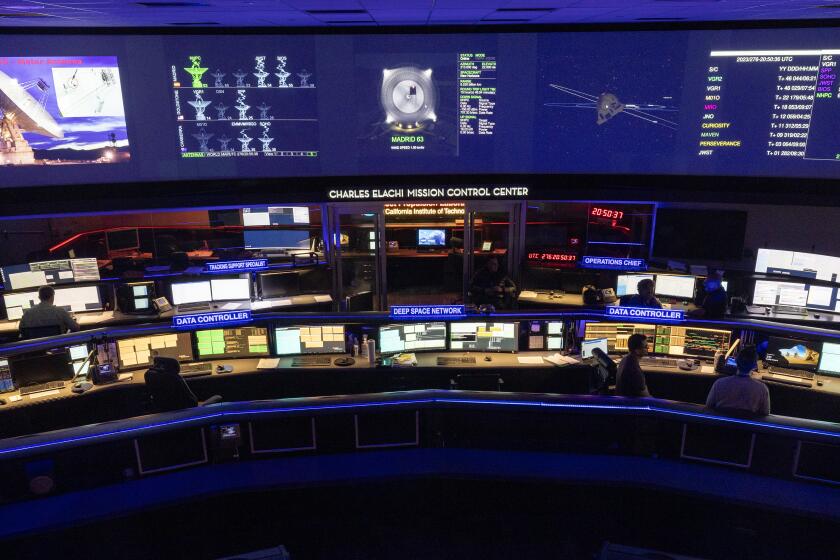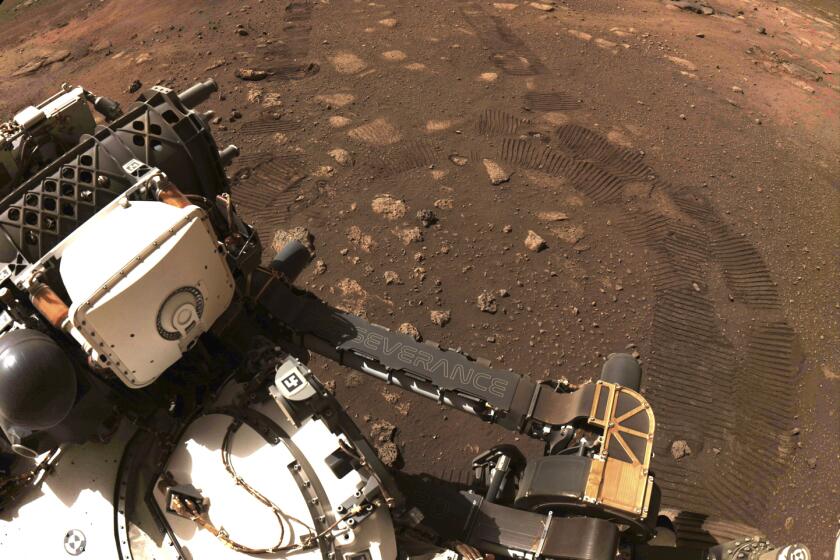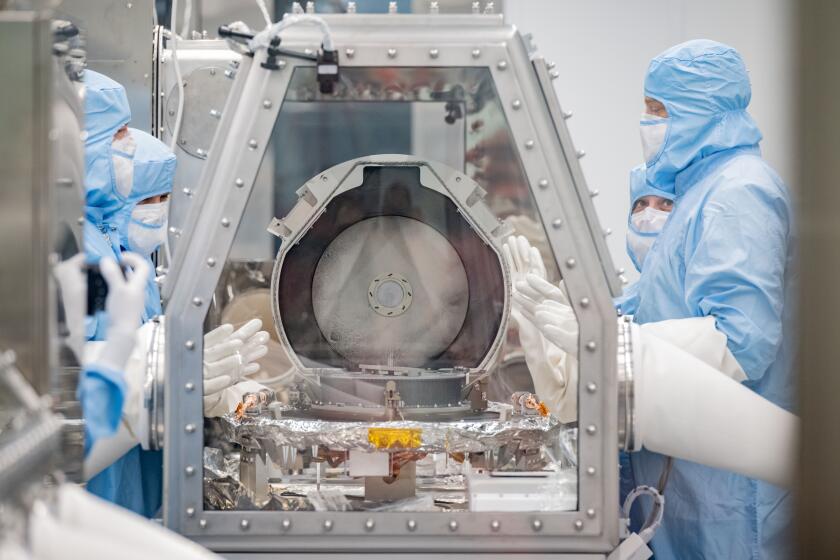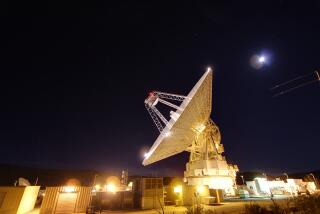Budget deal for NASA offers glimmer of hope for JPL’s Mars Sample Return mission
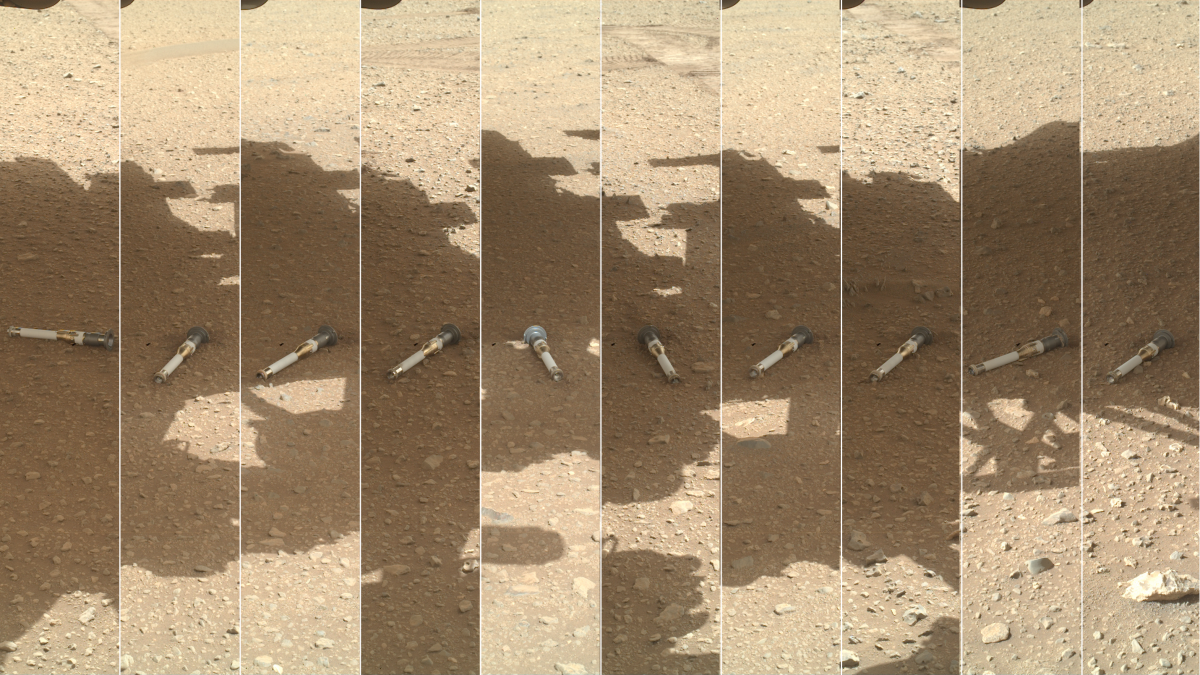
A bipartisan congressional agreement on NASA’s final budget for the current fiscal year offers a glimmer of hope that the space agency’s ambitious but troubled effort to bring pieces of Mars to Earth can recover from devastating cuts that led to hundreds of layoffs at the Jet Propulsion Laboratory in La Cañada Flintridge.
This week, the House and Senate appropriations committees finalized a deal that would grant a minimum of $300 million for the Mars Sample Return mission, which is managed by JPL. That’s a steep drop from the $822.3 million NASA spent on the program last year, and less than one-third of what the Biden administration requested.
Mars Sample Return would deliver rocks, rubble and dust from the Red Planet’s Jezero Crater that has already been gathered and sealed into tubes by the Perseverance rover. The MSR mission envisions a lander that would retrieve those tubes and use a small rocket to ferry them into Martian orbit, where they would rendezvous with a spacecraft that would make the journey back to Earth, arriving roughly five years after the orbiter’s launch.
The ultimate goal is to comb the samples for evidence that life has ever existed on Mars. That job may be left for future generations of scientists who will have access to technologies that don’t yet exist, NASA says.
A joint project with the European Space Agency, Mars Sample Return is an extraordinarily complex technical effort that scientists say would be a crucial step toward future human missions to Mars. Yet the project has been beset with delays and mounting costs.
NASA Administrator Bill Nelson directed the agency to brace itself for that $300-million figure earlier this year. That order has resulted in the loss of nearly 700 staff and contract jobs at JPL since January.
A hiring freeze wasn’t enough to avoid layoffs after NASA ordered cuts to the MSR mission. Some 530 employees and 40 contractors will lose their jobs.
The Senate appeared ready to condemn the mission altogether when it released its draft budget in July, writing that the appropriations committee was “alarmed” by the mission’s slow progress despite steady funding.
As a result, the Senate demanded a year-by-year breakdown of how NASA planned to fulfill the mission within the $5.3-billion then estimated as MSR’s total lifetime cost. Without that, the committee warned, “NASA is directed to either provide options to de-scope or rework MSR or face mission cancellation.”
In the budget agreement released Sunday, lawmakers clarified that the ultimatum in the Senate’s proposal was no longer on the table.
“MSR is the highest priority of the 2022 Planetary Science Decadal Survey but there is concern that the expected launch schedule continues to slip,” lawmakers said in a bipartisan statement from members of both the House and Senate.
Last year, NASA commissioned an independent review of the mission, which deemed MSR “not arranged to be led effectively” and hobbled by “unrealistic budget and schedule expectations from the beginning.” Making its planned 2027 and 2028 launch dates for the lander and orbiter is likely impossible, the review noted, and even a 2030 launch looks dubious without a massive injection of cash far greater than what Congress has budgeted.
Bringing back samples from the Red Planet would help us beat the Chinese, send humans into space and learn about how planets form. Congress, where’s the money?
NASA’s response to the review is expected this spring. Once that’s in, the current budget allows NASA 60 days to present Congress a plan for the mission’s future. This can include requests to redirect as much as $649 million in its budget to Mars Sample Return, which would raise program spending to the level Biden initially requested.
“The agreement further directs NASA to not engage in further workforce reductions of the MSR program until such report is provided,” the statement said.
In January, 100 on-site contractors at JPL were laid off after NASA told the lab to reduce spending, despite the strenuous objections of California lawmakers. Last month, the lab let go of 530 employees — approximately 8% of its workforce — and 40 additional contractors.
Many of those who lost their jobs were seasoned veterans whose departures shocked co-workers, JPL employees said.
Some of the state’s representatives in Washington expressed optimism that the mission could get back on track.
“This funding agreement is a step in the right direction to ensure that California continues to lead our nation’s space program,” Sen. Alex Padilla, a Democrat, said in a statement.
“The fight isn’t over,” Rep. Judy Chu (D-Monterey Park) said in a statement. “I urge NASA to swiftly apply the new appropriations guidelines so that officials can consider rehiring JPL employees and contractors who were laid off based on an outdated Senate appropriations bill that no longer is being considered by Congress.”
Late last year, a spacecraft containing samples of a 4.6-billion-year-old asteroid landed safely in the desert after a 1.2-billion mile journey.
A JPL spokesperson said this week that no staffing changes were expected at the lab before NASA’s response to the review is published. Late last month, NASA’s Office of Inspector General published its own audit of the Mars Sample Return mission, whose projected cost has nearly doubled to more than $10 billion since the program’s inception.
The audit determined that the difficulty of deciding upon a design for the mission’s Capture, Containment and Return System significantly threw off budget and timeline estimates. It also attributed some of the mission’s problems to a mismatch in management and communication styles between NASA and the ESA.
But in reckoning with past mistakes and planning a way forward, management must confront “characteristics intrinsic to big and complex missions like MSR ... for example, a full understanding of the mission’s complexity, initial over-optimism, a less than optimal design/architecture, and the team’s ability to perform to expectations,” the audit said. It warned project managers to “not simply attribute past cost growth to the COVID-19 pandemic, inflation, or supply chain issues.”
For the record:
7:44 a.m. March 7, 2024An earlier version of this article understated the size of the decrease in NASA’s full-year budget between 2023 and 2024 as being $500,000. It is $500 million.
The budget deal between the House and Senate appropriations committees allocates a total of $24.875 billion for all NASA operations this fiscal year, a $500 million decrease from last year’s budget. The difference is entirely due to the cut Congress demanded for the Mars Sample Return mission.
The numbers are not technically final until the budget passes, something that is expected to happen this week without further changes.
